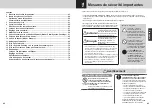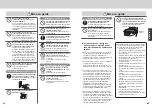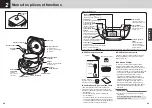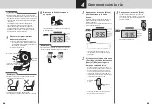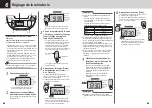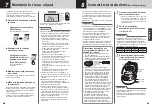
31
30
English
11
Cleaning and Maintenance
Any other servicing should be performed by an authorized service representative.
Perform cleaning and maintenance procedures as described on the following p.30 to 33.
Clean all parts by hand. Do not use a dishwasher/dryer.
To maintain cleanliness, always clean the rice cooker on the same day it is used. Also clean the rice cooker at
regular intervals as well.
The rice cooker should also be cleaned on the day that it is used in order to remove any odors that remain
from cooking. (See p.33.)
Note
●
Be sure to disconnect the power plug and allow the rice cooker, inner pot, inner lid, and pressure control
cap to cool down before cleaning.
●
Clean with a soft sponge and cloth.
●
When cleaning the rice cooker with a detergent, use only standard kitchen detergent (for tableware and
kitchen utensils).
●
Rinse the parts thoroughly since detergent remaining on them may result in deterioration and discoloration
of part’s materials such as resin.
Parts to wash after every use
Inner pot
Spatula
Cooking
plate
Pressure
control cap
Measuring
cup
Spatula holder
1
Clean with a soft sponge and with tap or lukewarm
water.
2
Wipe off water with a dry cloth and completely dry
all parts.
Note
●
Do not clean the inner pot with the abrasive side of a heavy-
duty scrub sponge. Doing so may damage the fluorocarbon
resin coating.
Do not use the abrasive side
of a heavy-duty scrub sponge.
●
Do not wash dishes, etc., inside the inner pot. Also, do not
place the inner pot upside down on top of dishes, etc., to
dry. Doing so may damage the fluorocarbon resin coating or
cause it to peel.
Parts to wash when dirty
Hook
button
Power
plug
Power
cord
Upper
casing
Heating
plate
Center
sensor
Heater
plate
Lid gasket
Inside and outside the rice cooker
Wet a towel or cloth, wring out excess water, and wipe.
Center sensor
Remove burned rice and any other adhering grains of rice.
If adhering objects are hard to remove, use commercially
available sandpaper (around #320), then wet a towel or
cloth, wring out excess water, and wipe.
Around the upper casing and hook button and on the
lid gasket
Remove any adhering grains of rice, etc.
Note
●
Do not allow water to get inside the rice cooker unit.
●
Do not immerse the power cord in or splash it with
water. Doing so may result in short-circuiting or electric
shock.
Power cord and plug
Wipe with a dry cloth.
Note
●
Do not pull on the lid gasket.
●
Always keep the inner pot and lid clean to prevent corrosion and odors.
●
Do not clean the rice cooker or its parts with thinner, cleanser, bleach, disposable cloth, metal spatulas,
nylon scouring sponges or the like.
●
Always clean each part separately.
●
Do not immerse the pressure control cap, measuring cup, spatula or spatula holder in hot water. Doing so
may cause them to become deformed.
●
Do not use a dishwasher/dryer to clean the rice cooker or its parts. Doing so may cause them to become
deformed.
●
When cleaning the rice cooker with a detergent, do not use alkaline kitchen detergent.
●
Always clean the lid or pressure control cap after cooking rice with cereal grains.
Otherwise the pressure control cap may be clogged causing a problem that the pressure control cap does
not open or rice cannot be cooked well.





















